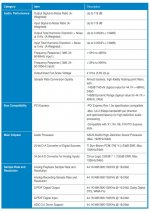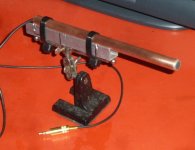Hi People,
I've built a fully active 2.1 - 2.5-way System with 2x Gradient W130 AL + a Monacor DTM 104/8 Tweeter left & right. Each chassis is powered by a LM3886 ChipAmp. As Crossover I use the EQ APO via my PC and an Asus Xonar D2X Soundcard. For the lowest Tunes there is a 12" Mivoc AW3000 Subwoofer, driven by two TDA7293 in parallel.
For my uneducated Ears, this all sounds pretty well, but I'm a complete Newbie and I'd like to hear YOUR Opinion. Where would you set the Crossover Frequencies, and which Crossovers would you choose?
best regards
J.
I've built a fully active 2.1 - 2.5-way System with 2x Gradient W130 AL + a Monacor DTM 104/8 Tweeter left & right. Each chassis is powered by a LM3886 ChipAmp. As Crossover I use the EQ APO via my PC and an Asus Xonar D2X Soundcard. For the lowest Tunes there is a 12" Mivoc AW3000 Subwoofer, driven by two TDA7293 in parallel.
For my uneducated Ears, this all sounds pretty well, but I'm a complete Newbie and I'd like to hear YOUR Opinion. Where would you set the Crossover Frequencies, and which Crossovers would you choose?
best regards
J.
Do you happen to have any pictures? 🙂
Between midrange and highs, I would cross as low as the tweeter allows. A 5" midrange and 1" dome tweeter usually cannot be crossed low enough to obtain a constant directivity around the crossover frequency anyway. Measuring harmonic distortion at your maximum listening SPL tells at what the lowest acceptable frequency would be.
Between midrange and highs, I would cross as low as the tweeter allows. A 5" midrange and 1" dome tweeter usually cannot be crossed low enough to obtain a constant directivity around the crossover frequency anyway. Measuring harmonic distortion at your maximum listening SPL tells at what the lowest acceptable frequency would be.
Last edited:
Yes, as low as the tweeter allows would be a good start. Avoid the woofer top end issues.
And cross the 0.5 according to the baffle.
And cross the 0.5 according to the baffle.
I too recommend as low as the tweeter will go. It looks like it should manage a 2kHz 4th order Linkwitz Riley acoustic.
It's typical to simply use an inductor. It's reasonable to flatten the impedance first (RC). How wide is your baffle?
I'm happy to guess, simulating or measuring would be better. Plus it's been a while since I've done a 2.5 way.. but if we say that the baffle step happens around 600Hz.. a 2mH inductor is 8 ohms at that frequency. Zobel calculations here - Introduction to designing crossovers without measurement
If it helps, I am using Equalizer APO, so I just have to type in the Numbers 😉. I don't have to build a physical Crossover.
Everything is working fine, but I don't have a Microphone for Measurements yet, and as I am a Greenhorn in doing diy Audio, I just wanted to hear the Opinion of some experienced Builders. At the Moment I've set the Crossovers at 75, 800 and 2500Hz. For my Ears it's Ok, I like what I hear.
As you have access to an unlimited number of filters, I would cross the 0.5 woofer as high as possible, such that it does not affect vertical dispersion. That relieves the other woofer from work in the midrange and lowers distortion. 600 Hz is reasonable.
I strongly recommend to buy or make a microphone and learn how to make measurements. That will positively affect the outcome (much) more than finding the perfect crossover frequencies and slopes. A simple small omnipolar electret capsule will do from 50 to 5000 Hz. Most pc sound cards already provide the required biasing voltage. Glue it to a chopstick (Gainphile: Cheap and accurate speaker measurement) and you are ready to go.
More info: Recording and Measurement Microphones
Once you wish to step up in quality, buy a microphone with a calibration report, a microphone stand, cabling and a decent external sound card.
I strongly recommend to buy or make a microphone and learn how to make measurements. That will positively affect the outcome (much) more than finding the perfect crossover frequencies and slopes. A simple small omnipolar electret capsule will do from 50 to 5000 Hz. Most pc sound cards already provide the required biasing voltage. Glue it to a chopstick (Gainphile: Cheap and accurate speaker measurement) and you are ready to go.
More info: Recording and Measurement Microphones
Once you wish to step up in quality, buy a microphone with a calibration report, a microphone stand, cabling and a decent external sound card.
Last edited:
Buying a microphone and becoming familiar with the tools and the possibilities of measuring is fix on my schedule 😉.
As I wrote, at the moment the 0.5 woofer goes up to 800Hz. I'll try 600 in a few minutes. Besides EQ APO I'm playing around with rePhase. Sure, a microphone would make things easier, but the budget says "No". I've read about the linear-phase-filter possibilities and made some tryouts with steep Linkwitz-Riley filters and brickwalls.
I'm thinking about another soundcard, but I'm not sure if this would be such an massive improvement. I've not the claim of being an"Audiophile", therefore my Ears are to tiny 😉. My Xonar D2X is not the worst solution and I've heard a few (I'm founder of the FB-group "IG-Altsilizium" and have been collecting rare and "special" hardware for years). The sound is beautiful and my PC-PSU shouldn't be trouble, also.
Thank you for the links, they will sure be helpful.
As I wrote, at the moment the 0.5 woofer goes up to 800Hz. I'll try 600 in a few minutes. Besides EQ APO I'm playing around with rePhase. Sure, a microphone would make things easier, but the budget says "No". I've read about the linear-phase-filter possibilities and made some tryouts with steep Linkwitz-Riley filters and brickwalls.
I'm thinking about another soundcard, but I'm not sure if this would be such an massive improvement. I've not the claim of being an"Audiophile", therefore my Ears are to tiny 😉. My Xonar D2X is not the worst solution and I've heard a few (I'm founder of the FB-group "IG-Altsilizium" and have been collecting rare and "special" hardware for years). The sound is beautiful and my PC-PSU shouldn't be trouble, also.
Thank you for the links, they will sure be helpful.
Attachments
Mind the USB microphones which can be difficult to use for timed measurements.
Linear phase, why? and without a microphone, I hope you're not expecting to avoid that thing called phase.
Linear phase, why? and without a microphone, I hope you're not expecting to avoid that thing called phase.
Thanks for the tipp! I'll do my homework before spending money.
Just playing around, get to know the Software, tried this > Windows PC as a FIR Audio Processor
It seems to work, sounded good, only the LP for the Subwoofer gets in conflict with the Soundcard Driver which has its own "FlexBass" Crossover. If I switch this off, then there isn't a signal at the Sub. It's dead then. I've got to read about this, somewhere in the net is an answer 😉.
Just playing around, get to know the Software, tried this > Windows PC as a FIR Audio Processor
It seems to work, sounded good, only the LP for the Subwoofer gets in conflict with the Soundcard Driver which has its own "FlexBass" Crossover. If I switch this off, then there isn't a signal at the Sub. It's dead then. I've got to read about this, somewhere in the net is an answer 😉.
10 euros will get you an electret capsule, a chopstick and a length of cable with a jack plug. 🙂Sure, a microphone would make things easier, but the budget says "No".
- Home
- Loudspeakers
- Multi-Way
- 2.5-way, 2x 5", 1x 1", crossover frequencies?

